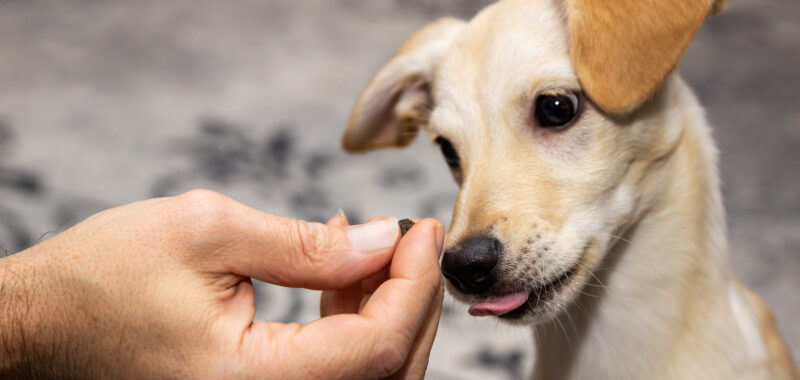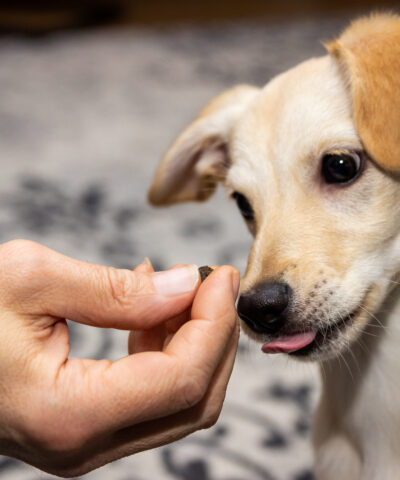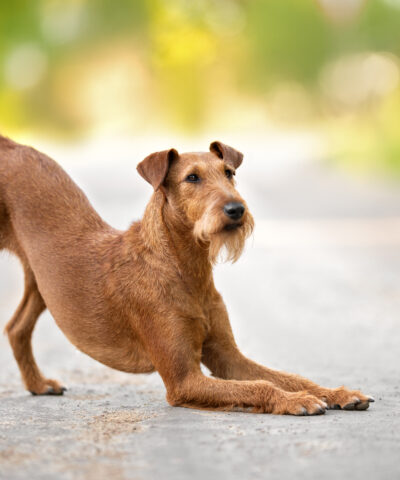Bringing a puppy into your home is an exciting and momentous occasion. It’s also the start of a journey where you become responsible for the well-being of a tiny, wiggly bundle of joy. Trust me; I know first-hand that caring for a puppy requires patience, love, and consistency. I have three at home, and to a greater or lesser degree, all of them have been a whirlwind of energy, mishaps, and unforgettable bonding moments, teaching me valuable lessons in companionship and care. Join me as I walk you through the essential aspects of puppy care.
Feeding
Why a Balanced Diet Matters
From the start, ensuring your furry friend gets a well-rounded diet is essential. A growing puppy needs the proper nutrients for their development.
Choosing the Right Food and Portion Sizes
As a general guideline, puppies thrive on diets of approximately 30-35% protein and 15%-20% fat. Look for foods that prioritise whole meats or meat meals as the main ingredients. High-quality kibble, with freshly prepared meat or fish, is also an excellent option for providing balanced nutrition. Our Green Pantry Puppy food is a complete, high-quality diet that ensures your puppy gets all the correct nutrition in its early days. Alternatively, companies like Pouch and Mutt, Lillys Kitchen and Edgard and Cooper have great options.
Remember to follow the recommended feeding portions based on your puppy’s weight and age and keep an eye on their weight to adjust as needed. Overfeeding can lead to joint problems and other health issues in the long run. Green Pantry’s specially formulated puppy diet offers all the nutrients and ingredients to ensure your little one receives the best natural nutrition.
Supplements
Certain supplements can also support your puppy’s growth and development. Omega-3 fatty acids are important to support brain and eye development, while glucosamine and chondroitin contribute to joint health. Before adding any supplements to your puppy’s diet, it’s always best to consult with your veterinarian.
Training
Essential Commands for Obedience Training
Let’s start with the basics: teaching your puppy to ‘sit’, ‘stay’, ‘come’, ‘down’, and ‘heel’ forms the foundation of obedience training. Consistency is vital, so please make sure everyone in your household uses the same commands. Early training is essential, particularly to set your puppy up for when it starts to make a regular appearance in the outside world. Remember, not everyone likes dogs in the way we do!
Positive Reinforcement
When training your furry friend, positive reinforcement is the way to go. By using praise, treats (why not try one of Green Pantry’s new air-dried treats), and dedicated playtime, you can effectively reward your puppy for good behaviour and encourage them to repeat it. Positive reinforcement can help develop the bond between you and your puppy and help them associate training with positive experiences.
On the other hand, it is essential to avoid using punishment or negative reinforcement in training. These methods can create fear and mistrust in your puppy, hindering its progress and potentially damaging your relationship. Focusing on positive reinforcement helps develop a supportive environment for your puppy to learn and grow.
Housetraining
Steps for Successful Housetraining
Again, consistency is critical here. Make sure to take your puppy out first thing in the morning, after meals and naps, and before bedtime. And when they do their business outside, remember to reward them for being such good boys and girls! For all three of our dogs, I cannot emphasise how critical routine was for housetraining them as puppies.
Dealing with Accidents
Accidents happen, no doubt about it. But when they do, stay calm. There is no need to scold your puppy—accidents are just part of the learning process. Use a pet-specific odour eliminator to clean up messes and remove tempting scents that might attract them back to the same spot.
Health Care
Regular Vet Checkups and Vaccinations
Regular vet visits for vaccinations and checkups will track your puppy’s growth and help prevent various diseases. They’re also a chance to discuss a schedule for deworming and flea control.
Upon collecting your puppy, it’s also worth double-checking that it has had its 8-week vaccination and booking it in for its 12-week vaccination.
And, while it is the breeder’s responsibility to ensure the puppy has been microchipped, double-check this one, too.
Common Health Issues and Preventive Measures
Be on guard for signs of illness, such as diarrhoea, vomiting, or loss of appetite, and consult your vet promptly if these arise. Remember that a puppy’s immune system is weaker than that of a mature dog, making it more susceptible to these issues.
The Importance of Exercise for Puppies
Regular exercise is super important for a puppy’s overall health and development. It helps your puppy stay at a healthy weight, strengthens their body and keeps their mind sharp. Plus, exercise gives them an outlet for all that energy and curiosity, so they don’t get bored and start chewing up everything in sight. Not only does exercise help them grow strong, but it also plays a significant role in training them to be well-behaved. Going for walks, playing, and training sessions can boost their obedience skills, socialisation, and bond with you and the family. Remember, a tired puppy is very often a happy puppy. Just make sure to adjust the amount and intensity of exercise based on age, size, and breed so they don’t overdo it. And if you need to figure out how much activity suits your puppy, it’s always a good idea to check with your vet.
Proper Lead and Collar Usage
When choosing a collar or harness for your pup, pick one that fits them well and is comfortable. And remember, the lead doesn’t have to be a scary thing! Introduce it during playtime so they associate it with fun and positive experiences. Treats, such as the Green Pantry range of Natural Treats, can be an excellent way to reward them when introducing them to a lead and collar for the first few times.
Training a Puppy to go for a walk on a Lead
Start with short walks to let your puppy get used to the lead and explore their surroundings. Take it slow and give them time to feel comfortable.
Socialising
Why Early Socialisation is Crucial for Puppies
Socialising your puppy at an early age is incredibly important as it exposes them to a wide range of people, sights, sounds, and experiences. This foundation helps them become well-adjusted dogs.
At home, we’ve always made it a priority to socialise our dogs when they were young. However, when we got a puppy (called Smoothie) just before lockdown, she missed out on meeting other dogs and people and experiencing new things at that early age. I remember thinking it wouldn’t be a problem, as we already had two older and very friendly dogs. So, I was surprised, in fact, just how long it took her as a teenage dog to feel entirely comfortable outside of her home, having missed out on all that socialisation as a lockdown puppy.
Tips for Introducing Puppies to New Experiences
To expose your puppy to new experiences, consider planning visits to parks and outdoor cafes or taking them for walks in busy areas. Always prioritise your puppy’s comfort and safety during these outings, and try to avoid doing any of this in too much of a rush!
Meeting Other Dogs
How to Safely Introduce Your Puppy to Other Dogs
So, you’ve got a new furry friend and are excited to introduce them to other dogs. It is essential to take things slow and create a safe environment for their first encounters. Monitor their interactions and step in if things get too rowdy.
Tips for Positive Social Interactions
Enrolling your puppy in socialisation classes is an excellent idea that will benefit you and your puppy. These classes provide a fantastic opportunity for your puppy to learn critical social skills and socialise with other dogs in both a supervised and safe environment. Not only will this help them become well-rounded and confident, but it will also strengthen the bond between you and your puppy! Additionally, these classes allow them to meet other dogs and teach them some vital doggy etiquette. Remember, the earlier you start their socialisation journey, the better. And hey, it’s not just for puppies – socialisation should be an ongoing thing throughout your dog’s life, and who knows, you may even meet some new friends yourself.
Chewing and Crying
Tips for Stopping Puppies from Chewing
So, how can puppy chewing habits be stopped? First, offer plenty of chew toys to redirect their attention. Chewing is typically a symptom of boredom, so keeping your puppy well-exercised and well-occupied is usually an excellent place to start. It’s also good to puppy-proof your house by keeping items you don’t want chewing out of reach.
Tips for Dealing with Separation Anxiety and Excessive Crying
We understand that dealing with separation anxiety and excessive crying can be challenging. Help your puppy create a safe space, like a cosy crate or a puppy pen. Leave them with a treat-filled toy to keep them busy and comforted when you have to step away.
Grooming
Essential Tips for Grooming Your Puppy
Grooming is not just about keeping your puppy looking their best; it’s also crucial for their health and well-being. Let’s dive into some essential grooming tips that you should know. Start grooming routines early, so your puppy gets used to it. Regular brushing, based on coat type, will keep their fur clean and free of mats. Remember to check and clean their ears to prevent any infections. Keeping their nails trimmed to a comfortable length is essential, too. Dog dental hygiene is also important, so remember to brush your teeth with dog-specific toothpaste. And, of course, bathing should be done as needed, using a gentle puppy-friendly shampoo to maintain the natural oils in their coat.
Taking a Dog to Work
Tips for Bringing Your Puppy to the Workplace
If you’re lucky enough to be able to take dogs and puppies to work, we have some tips to make it a smooth experience. First and foremost, make sure your workplace is dog-friendly. Bring a cosy crate or a comfy bed for your puppy to relax in. Remember to pack some chew toys to keep them entertained. Also, remember to plan lunch breaks during your work day. Remember what we said about routine. Planning is key.
Creating a Dog-friendly Environment
Creating a dog-friendly environment is critical to ensuring a positive experience for everyone. Plan regular bathroom breaks to keep accidents at bay. When your puppy is not confined, please watch it to ensure its safety and comfort. Remember to be conscious that only some of your colleagues at work are as comfortable around dogs and puppies as you are.
Conclusion
Your puppy relies on you for guidance, care, and love. The tips we’ve shared here, backed by research and personal experiences, will help you nurture a healthy, friendly, and well-behaved dog. Patience and love are the keys to having a disciplined pet and a loyal companion for years. Cherish every moment and watch as your puppy grows into the heart and soul of your home.
Written By Tom and the Green Pantry team, with help from all their dogs.





